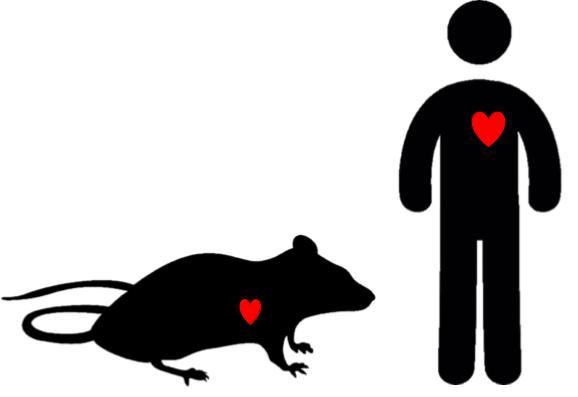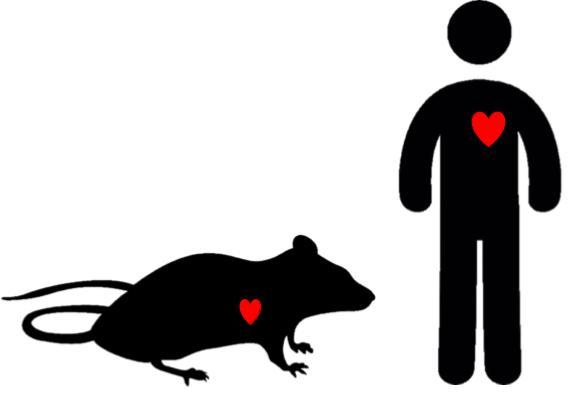
Credit: Image by The University of Tokyo. No copyright restrictions.
Individual cells within the same heart cope differently with high blood pressure, according to a study in human cells and mice by a team of cardiologists and computational biologists at the University of Tokyo. This is the first time researchers have identified distinct differences between heart muscle cells that fail and those that adapt to high blood pressure.
Cardiovascular diseases are the number one cause of death worldwide, according to the World Health Organization. High blood pressure causes heart failure, but the underlying mechanism by which this occurs is unknown.
In this new study, cells that adapted to high blood pressure were thicker overall than healthy cells. These thicker cells needed more energy, but could keep the heart beating. Cells that failed to adapt became stretched out and weak, like a worn-out elastic band, and could contract to keep blood pumping.
Project Assistant Professor Seitaro Nomura, a cardiologist at the Graduate School of Medicine and a postdoctoral researcher at the Research Center for Advanced Science and Technology, is first author of the research paper.
"These results are the first to show that some cells fail and others adapt to high blood pressure within the same heart. I am very interested in the increased activity of genes that are important for making energy in the cell," said Nomura.
The scientists identified multiple groups of genes that had increased or decreased activity when cells coped with high blood pressure, but focused on one gene called p53. In failing cells, p53 showed increased activity. Researchers suspect p53 sends cells down a path either of failing or adapting to increased pressure. This gene is familiar to cancer researchers for responding to DNA damage and maintaining cell growth and division.
Nomura and other researchers examined the gene activity of hundreds of individual cells from a small number of mice and human heart surgery patients. Identifying the gene activity of single cells, rather than averaging the gene activity of many cells, is known as single-cell transcriptome analysis and can reveal differences between cells from the same individual.
Ongoing research in the University of Tokyo laboratories of Professor Hiroyuki Aburatani at the Research Center for Advanced Science and Technology and Professor Issei Komuro at the Graduate School of Medicine will continue to investigate the cellular signals that connect p53 to the paths of heart cells failing or adapting to high pressure.
"Scientists already know how to reprogram adult cells into induced pluripotent stem (iPS) cells," said Nomura, referring to the 2012 Nobel Prize-winning research that gives adult cells the ability to revert to an immature state. "This gives me confidence that eventually, we may find a way to reprogram failing heart cells into adaptive heart cells," said Nomura.
Cardiologists of the future may be able to coax cells to adapt to the high pressure of hypertension, a narrow aorta, or heart attack and prevent heart failure.
"Combining computational analysis with experimental medical techniques can extend our knowledge and improve the laboratory bench-to-patients' bedside process of research," said Nomura.
###
Background Information
Some medical conditions that can cause either chronic or acute increases in blood pressure are aortic stenosis (narrowing of the aorta), hypertension (high blood pressure), and myocardial infarction (heart attack).
Visit the World Health Organization website for a fact sheet on cardiovascular diseases: http://www.who.int/en/news-room/fact-sheets/detail/cardiovascular-diseases-(cvds)
About the Research
The study was completed with collaborators in Japan at Chiba University Graduate School of Medicine, Osaka University Graduate School of Medicine, Tokyo Women's Medical University, and RIKEN Center for Integrative Medical Sciences.
The research paper is a peer-reviewed experimental study using human cell samples and male mice published in Nature Communications.
Journal Article
Nomura S, Satoh M, Fujita T, Higo T, Sumida T, Ko T, Yamaguchi T, Tobita T, Naito AT, Masamichi I, Fujita K, Harada M, Toko H, Kobayashi Y, Ito K, Takimoto E, Akazawa H, Morita H, Aburatani H, Komuro I. Cardiomyocyte gene programs encoding morphological and functional signatures in cardiac hypertrophy and failure. Nature Communications. 30 October 2018. DOI: 10.1038/s41467-018-06639-7
Related Links
Graduate School of Medicine, The University of Tokyo: http://www.m.u-tokyo.ac.jp/english/index.html
Research Center for Advanced Science and Technology, The University of Tokyo: http://www.rcast.u-tokyo.ac.jp/index_en.html
Aburatani Lab homepage: https://www.genome.rcast.u-tokyo.ac.jp/en/research
Research Contact
Seitaro Nomura, M.D., Ph.D.
Graduate School of Medicine, The University of Tokyo, 7-3-1 Hongo, Bunkyo-ku, Tokyo 133-0033, JAPAN
Tel: +81-3-5452-5031
Email: [email protected]
Press Contacts
Ms. Caitlin Devor
Division for Strategic Public Relations, The University of Tokyo, 7-3-1 Hongo, Bunkyo-ku, Tokyo 133-8654, JAPAN
Tel: +81-3-5841-0876
Email: [email protected]
Ms. Rimika Koiwai
Center for Liaison and Public Relations, The University of Tokyo Hospital, 7-3-1 Hongo, Bunkyo-ku, Tokyo 133-8655, JAPAN
Tel: +81-3-5800-9188
Email: [email protected]
About the University of Tokyo
The University of Tokyo is Japan's leading university and one of the world's top research universities. The vast research output of some 6,000 researchers is published in the world's top journals across the arts and sciences. Our vibrant student body of around 15,000 undergraduate and 15,000 graduate students includes over 2,000 international students. Find out more at http://www.u-tokyo.ac.jp/en/ or follow us on Twitter at @UTokyo_News_en.
Media Contact
Seitaro Nomura, M.D., Ph.D.
[email protected]
81-354-525-031
@UTokyo_News_en
http://www.u-tokyo.ac.jp
Related Journal Article
http://dx.doi.org/10.1038/s41467-018-06639-7





